COVID-19 has disrupted our lives with concerns of getting sick and the limitations of quarantining. Since a lot of us have more time on our hands, we can dive into the books we’ve wanted to read but kept putting off. Those factors make now a good time to escape into a fictional version of New York, one patrolled by Matt Murdock’s alter ego, Daredevil, the Man Without Fear.
Editor’s note: These books are listed with their original cover prices. Later editions may have different prices. If there are no later editions, the secondary market may place a premium on the present prices.
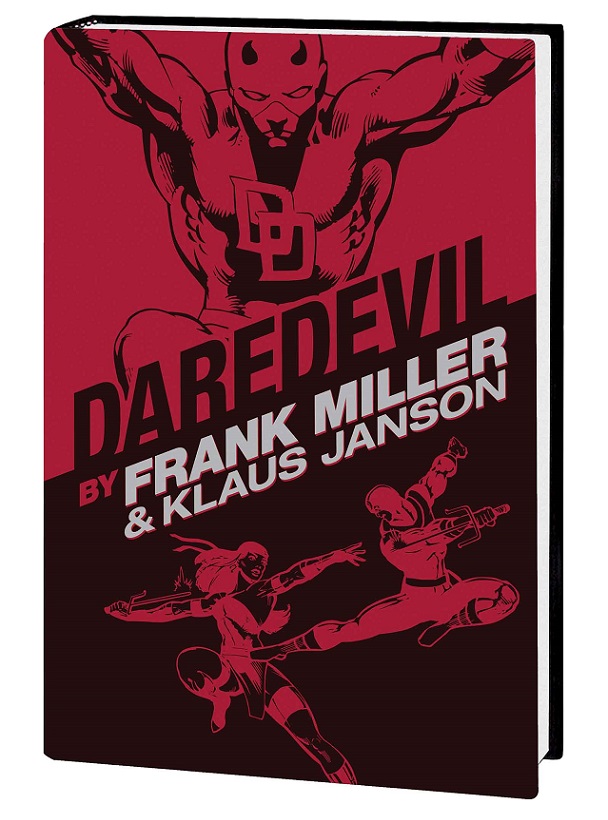 Daredevil by Frank Miller & Klaus Janson Omnibus
Daredevil by Frank Miller & Klaus Janson Omnibus
Marvel Comics; $99.99
There had been a lot of really good and even a few great stories in the pages of Daredevil before Frank Miller came along, and there certainly had been some fantastic art before his arrival as well. Think about it: Wally Wood, John Romita, Sr., Gene Colan… (Colan’s art for many had defined the character’s sensibilities). Lots of great stuff. Colan came as close as anyone to owning the character.
But it was Frank Miller who took the floundering title, put it on his back, and set the comic book world a-talking. With the series initially scripted by Roger McKenzie, Miller’s pencils were paired with Klaus Janson’s inks (As an inker, colorist, and eventually as penciller, Janson probably has more issues of Daredevil under his belt than anyone) and the result was magic.
Following his debut on Daredevil #158, Miller’s storytelling skills grew exponentially. It wasn’t even issue by issue, but page by page.
Miller took over as writer with Daredevil #168, which featured the introduction of Elektra. The series or the title character have never been the same since.
In addition to creating Elektra, Miller introducing The Hand, making Bullseye the truly psychotic villain he is today, layered the depth of Matt Murdock and Foggy Nelson’s relationship, and that of Matt and Natasha Romanov, the Black Widow, he also stunningly made that no one thinks of the Kingpin as a Spider-Man villain anymore.
No, he belongs to Daredevil. And Frank Miller did that.
This omnibus contains Miller and Janson’s whole run, #158-161 and #163-191 (Terry Austin inked #191). It’s amazing to see Miller’s transition from artist to writer and the seamless, fluid progression and Janson takes over more and more of the art. The material in this book defined Daredevil for a generation of fans. If you haven’t read it before, it’ll do the same for you.
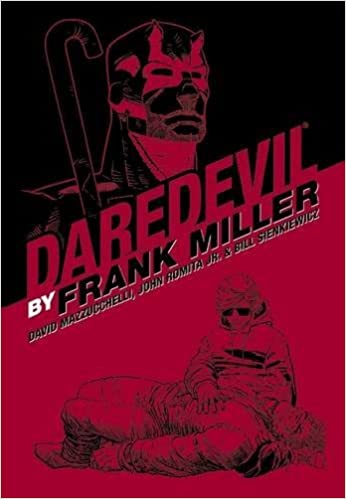 Daredevil by Frank Miller Omnibus Companion
Daredevil by Frank Miller Omnibus Companion
Marvel Comics; $59.99
They said you can never go home again, but they neglected to tell Frank Miller. This book collects the Frank Miller Daredevil material that didn’t fit into the first omnibus. A two-part assignment on Peter Parker, The Spectacular Spider-Man #27-28 was the first time he drew the character. A one-issue return as writer paired him with John Buscema on Daredevil #219.
The meat of this book, though, begins with the single issue story in Daredevil #226 and then the epic “Born Again” arc that kicks off with #227. For this Miller was teamed with artist David Mazzucchelli, and together they ended up redefining Matt Murdock and his supporting cast again. Not only did this cement Kingpin as a Daredevil villain, but it built on the noir sensibilities that Miller and Janson had instilled earlier. If it was only for “Born Again,” the book would easily be worth the price of admission, but there’s two other big components.
Miller teamed with Bill Sienkiewicz for Marvel Graphic Novel #24, Daredevil: Love and War, another insightful excursion into the Daredevil – Kingpin relationship, and with penciller John Romita, Jr. and inker Al Williamson for the five-part Daredevil: The Man Without Fear, a look at how Matt Murdock got to be Daredevil.
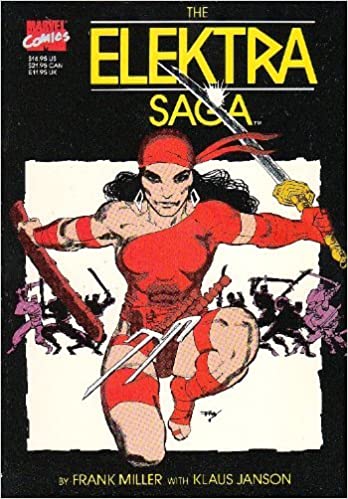 The Elektra Saga
The Elektra Saga
Marvel Comics; 16.95
Originally published as a four-issue miniseries, The Elektra Saga was a relatively unique undertaking when it was first published. Frank Miller took the existing art from his collaboration with Klaus Janson on Daredevil (and one short story from the pages of Bizarre Adventures) and recut the pages to tell the story from Elektra’s perspective.
While it lacks the punch of seeing the material for the first time, it nonetheless does indeed manage to create a new perspective and gives the reader – particularly the devoted Daredevil fan – great insight into Elektra and how she got to be the way she is.
Since this volume is typically not in print, it’s definitely worth picking up if you stumble across it in back issue bins, on bookshelves, or online. It’s particularly attractive for Miller fans who most likely will quickly spot the five new pages (plus three panels) he illustrated for the series.
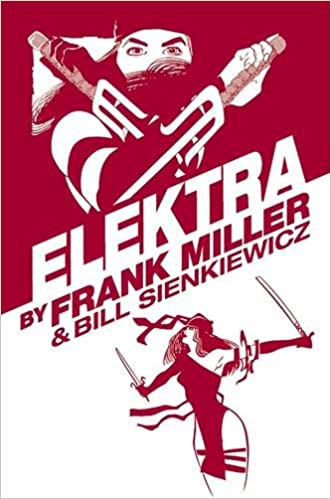 Elektra by Frank Miller & Bill Sienkiewicz
Elektra by Frank Miller & Bill Sienkiewicz
Marvel Comics; $100
Combining Elektra’s stories from Bizarre Adventures (in black and white as originally published), What If #35, Elektra: Assassin, and Elektra Lives Again, this book features the remainder of Frank Miller’s work on his creation. The short story from Bizarre Adventures fairs better in black and white reproduction than those pages did in color in The Elektra Saga, and the What If? tale is certainly worth the read, but it’s the Miller-Sienkiewicz collaboration on the eight-issue Elektra: Assassin miniseries that serves as this volume’s main attraction.
Thought-provoking from its first page, Elektra: Assassin heads for the edge and lives there successfully for its full run. Taken in tandem with Daredevil: Love and War, it always makes me wish Miller and Sienkiewicz had done more together.
The original graphic novel Elektra Lives Again is also collected in this book. Long delayed when it was originally released, it’s Miller’s most uneven work on the character. It has aged well, though, and it is definitely worth a look.
The last interesting tidbit in this book are the original covers Miller created for the individual issues and the trade paperback of The Elektra Saga. They are beautifully reproduced.
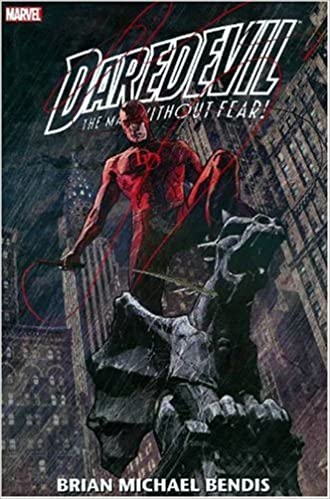 Daredevil by Brian Michael Bendis – Volume 1
Daredevil by Brian Michael Bendis – Volume 1
Marvel Comics; $100
Great Daredevil runs rarely follow other great Daredevil runs. There are almost always some so-so issues in between. Here’s an exception. Though short, David Mack’s run as the book’s writer with Joe Quesada and Jimmy Palmiotti on art was superb. It was preceded by a four-issue art with Mack on art (always glorious) written by Brian Michael Bendis. It was followed by the beginning of the long Bendis-Alex Maleev collaboration. This volume contains Daredevil #16-19, 26-50, and 56-60 (there’s also a Volume 2 after you read this one).
Bendis and Maleev had collaborated on a short run on Sam & Twitch for Todd McFarlane at Image, and fans of that series had a good indication of what was to come. As collaborations go, this was a match made in Heaven. The crime-noir sensibility permeated the series from the first pages and signaled a sea change in the book – or so it seemed. Bold moves, superior storytelling, and Matt Hollingsworth’s colors made this era unforgettable.
If your inclination is to think that no other creator could own Daredevil after Frank Miller, here's a chance to reevaluate your thinking.











